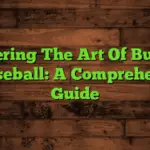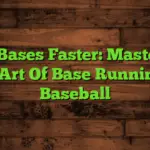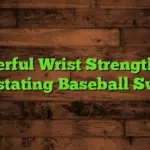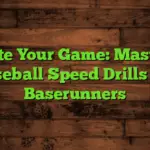Throwing a baseball requires incredible strength, precision, and coordination. But the repetitive motions and forceful throws can take a toll on your arm, shoulder, and elbow, leading to injuries. How to recover from a baseball throwing injury is a question many pitchers and position players face, and the answer is multifaceted and depends on the specific injury. This guide will explore various aspects of recovery, from understanding common injuries to advanced rehabilitation techniques. You’ll learn about rest, ice, compression, elevation (RICE), physical therapy, strengthening exercises, and the importance of preventative measures to return to the game stronger and healthier.
Baseball throwing injuries frequently affect the shoulder, elbow, and rotator cuff. These injuries can range from minor strains and sprains to more serious conditions like rotator cuff tears, labral tears, ulnar collateral ligament (UCL) injuries, and epicondylitis
(golfer’s or tennis elbow). The severity depends on the force of the throw, the player’s physical condition, and the presence of pre-existing conditions.
Shoulder Injuries in Baseball
Rotator Cuff Tears
The rotator cuff is a group of muscles and tendons that stabilize the shoulder joint. Overuse or sudden trauma can tear these muscles, leading to pain, weakness, and limited range of motion. Recovery involves rest, physical therapy, and sometimes surgery.
Labral Tears
The labrum is a ring of cartilage that adds stability to the shoulder joint. A labral tear can result from repetitive throwing motions or a direct impact. Symptoms include pain, clicking, and instability. Treatment options include conservative management with physical therapy or surgery depending on the severity.
Elbow Injuries in Baseball
Ulnar Collateral Ligament (UCL) Injuries
The UCL stabilizes the elbow joint, crucial for throwing. Overuse, especially in young pitchers, can lead to UCL sprains or tears. This injury often requires Tommy John surgery, a procedure to replace the damaged ligament.
Epicondylitis (Golfer’s or Tennis Elbow)
Epicondylitis is inflammation of the tendons that attach to the elbow. Golfer’s elbow affects the inside of the elbow, while tennis elbow affects the outside. Repetitive throwing motion can cause this condition. Treatment focuses on rest, ice, physical therapy, and anti-inflammatory medications.
Diagnosis and Assessment
Medical Evaluation
A proper diagnosis is crucial for effective recovery. This often involves a physical examination, imaging tests (X-rays, MRI, ultrasound), and possibly electromyography (EMG) to assess muscle and nerve function. A sports medicine specialist or orthopedic surgeon can provide an accurate diagnosis and recommend a treatment plan.
Initial Treatment: RICE Protocol
Rest, Ice, Compression, Elevation
The RICE protocol is a cornerstone of initial injury management. Rest allows the injured tissues to heal. Ice reduces inflammation and pain. Compression minimizes swelling, and elevation keeps fluid from pooling in the affected area.
Physical Therapy and Rehabilitation
Targeted Exercises
Physical therapy plays a vital role in regaining strength, flexibility, and range of motion. A physical therapist designs a customized rehabilitation program, including range-of-motion exercises, strengthening exercises (isometric, concentric, and eccentric), and proprioceptive exercises to improve balance and coordination.
Strengthening and Conditioning Programs
Progressive Loading
Strengthening exercises should be progressive, gradually increasing the intensity and weight to avoid re-injury. This includes exercises targeting the rotator cuff, shoulder, and elbow muscles. Examples include: internal/external rotations, rows, and bicep curls.
Importance of Proper Throwing Mechanics
Biomechanics Analysis
Analyzing throwing mechanics can identify flaws that contribute to injuries. A biomechanics specialist can assess your throwing motion, identify areas for improvement, and develop a plan to correct them. This is crucial for preventing future injuries.
Nutrition and Recovery
Dietary Considerations
Proper nutrition supports muscle repair and healing. Focus on a balanced diet rich in protein, vitamins, and minerals. Sufficient protein intake is crucial for muscle growth and repair.
Mental Health and Recovery
Addressing Psychological Aspects
A baseball injury can affect your mental well-being. Addressing the emotional aspects of recovery is important. Consider working with a sports psychologist or counselor to manage stress, anxiety, and depression related to the injury and recovery process.
Prevention of Baseball Throwing Injuries
Warm-up and Cool-down Routines
Proper warm-up and cool-down routines are essential. Warm-up prepares your muscles and joints for activity, reducing the risk of injury. Cool-down helps reduce muscle soreness and promotes recovery.
Return to Play
Gradual Progression
Returning to play is a gradual process. Start with light throwing, gradually increasing the intensity and distance as your strength and flexibility improve. Listen to your body and don’t push yourself too hard, too soon.
Long-Term Management
Maintaining Strength and Flexibility
Continued strength and flexibility training are essential for long-term injury prevention. Incorporate regular exercise and stretching into your routine to maintain optimal physical condition.
The Role of Sports Medicine Specialists
Expert Guidance
Sports medicine specialists play a crucial role in diagnosing and treating baseball throwing injuries. They have expertise in sports-related injuries and can provide guidance on rehabilitation, recovery, and return-to-play strategies.
Alternative Therapies
Complementary Approaches
Alternative therapies such as acupuncture, massage therapy, and chiropractic care can complement traditional medical treatments and may help alleviate pain and promote healing. However, consult your physician before incorporating alternative therapies.
Frequently Asked Questions
What is the most common baseball throwing injury?
Shoulder and elbow injuries are the most common, encompassing rotator cuff tears, labral tears, UCL injuries, and epicondylitis.
How long does it typically take to recover from a baseball throwing injury?
Recovery time varies greatly depending on the severity of the injury and the individual’s response to treatment. Minor injuries may heal within a few weeks, while more serious conditions could require months or even surgery.
Can I play baseball after a throwing injury?
Yes, but only after a thorough recovery process. Your physician and physical therapist will determine when you can safely resume baseball activities.
What are the signs of a serious throwing injury?
Severe pain, inability to use the arm, significant swelling, and a noticeable deformity are signs of a potentially serious injury, warranting immediate medical attention.
Is surgery always necessary for UCL injuries?
Not always. Mild UCL sprains can often be treated non-surgically with rest, physical therapy, and rehabilitation. However, more severe tears often require Tommy John surgery.
What exercises can help prevent baseball throwing injuries?
Strengthening exercises for the rotator cuff, shoulder, and elbow muscles are crucial. These include internal/external rotations, rows, and bicep curls. Proper stretching is also vital.
How can I improve my throwing mechanics?
Work with a pitching coach or biomechanics specialist to analyze your throwing motion and identify areas for improvement. Correcting poor throwing mechanics can significantly reduce injury risk.
Final Thoughts
Recovering from a baseball throwing injury requires a comprehensive approach, combining medical treatment, physical therapy, and preventative measures. It’s a journey that demands patience, perseverance, and a commitment to following a personalized recovery plan. Remember that the timeline for recovery varies, and prioritizing proper rest and rehabilitation is key to a successful return to the game. Consulting with a medical professional is crucial for accurate diagnosis and appropriate treatment. Don’t rush the process; focus on complete healing to prevent future injuries and ensure a long and successful baseball career. By diligently following the advice provided in this guide, you can significantly enhance your chances of a full recovery and a successful return to the game you love. Remember to listen to your body, prioritize rest, and work closely with your medical team to guide your recovery.





